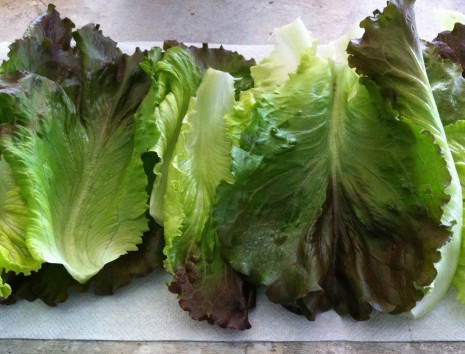SALAD SLOTH
The last thing I want to do during the pre-dinner hustle—especially on a weeknight—is haul out the salad spinner and prep salad greens. Not only is it a royal pain, but damp leaves aren’t very receptive to a vinaigrette or other dressing (for three classics, click here).
That’s why, a few days ahead of time, I wash and dry the greens, then loosely roll them in paper towels and pop them in a plastic bag. The object here is to remove any excess water (to forestall decay), while helping the greens retain their own moisture, and I learned the trick from my former colleagues at Gourmet. It works fabulously well—except, of course, when I don’t have the time, energy, or inclination to follow through. And then it’s all too easy to put off that virtuous salad until another night, and then another. Goodness, how the week can fly by.
I look at those untouched heads of lettuce tucked away in the crisper drawer and suffer a major attack of the guilts. Slightly wilted leaves can be revived in cold water, but what about the nutrients? Lettuce is no lightweight: The delicate leaves are full of potassium and beta-carotene, which is converted to vitamin A in the body. We all tend to think of beta-carotene as the prerogative of carrots and other brightly colored vegetables, but in lettuce, the yellow-orange pigment is hidden by green chlorophyll. Lettuce also contains vitamin C, calcium, iron, and copper; in general, the darker the leaf, the more nutritious it is.
I got to feeling better about my salad sloth after researching nutrient retention for a reader’s question—more accurately, a cri de coeur—that appeared a while back in my weekly column for the food-forward environmental website TakePart. (Forgive the shameless self-promotion, but, hey, they pay me to learn really cool stuff and then write about it.)
One of the absorbing things I came across was a September 2007 piece titled “Evolution of Antioxidant Capacity during Storage of Selected Fruits and Vegetables,” published in the Journal of Agricultural and Food Chemistry. The researchers, molecular biologists at the University of Liège, in Belgium, found that in most fruits and vegetables, storage does not adversely affect antioxidant capacity. “In some cases, an increase of the antioxidant capacity was observed in the days following their purchase, accompanied by an increase in phenolic compounds,” they wrote. “In general, fruits and vegetables visually spoil before any significant antioxidant capacity loss occurs except in banana and broccoli. When ascorbic acid or flavonoids … were concerned, the conclusions were similar. Their content was generally stable during storage.” What a relief.
That particular study never made its way into my column, but one that did was a very recent discovery, published in the journal Current Biology, by scientists at Rice University and the University of California at Davis. They found that for days after harvest, lettuce—as well as cabbage, spinach, zucchini, carrots, sweet potatoes, and blueberries—continue to respond to circadian rhythms (day-night cycles of light), allowing them to ramp up the phytochemicals that protect them from being eaten by insects and other herbivores at certain times of the day. Interestingly, those same chemical compounds have anticancer effects when eaten by humans.
It’s not known yet whether all-dark or all-light conditions shorten the shelf life of fruits and vegetables, but it’s amazing to think that we could boost the health benefits of produce simply by how we store it. I’ll keep you posted.
Posted: September 24th, 2013 under early autumn, Gourmet magazine, kitchen science.


